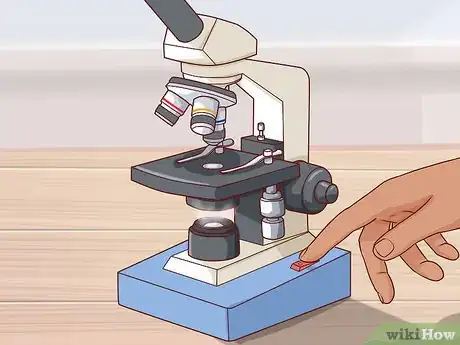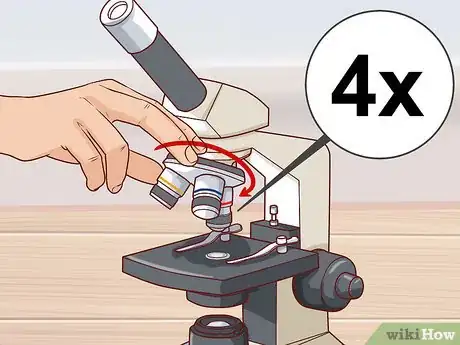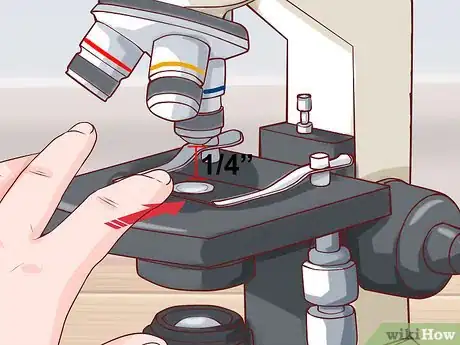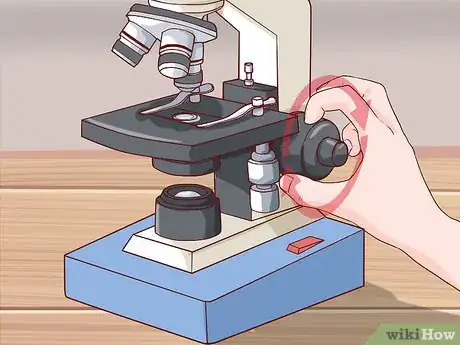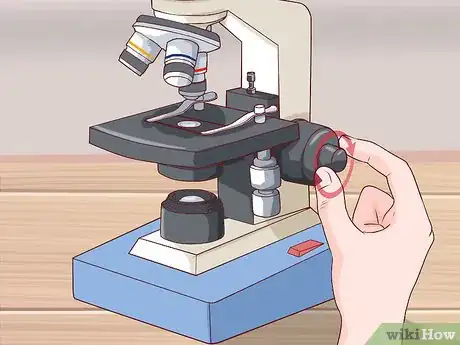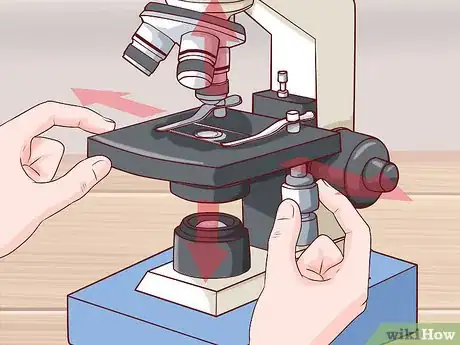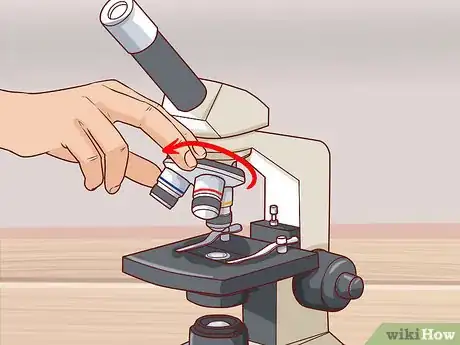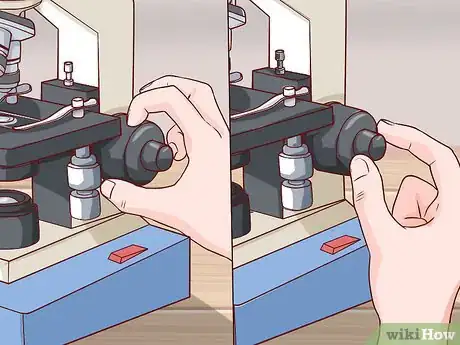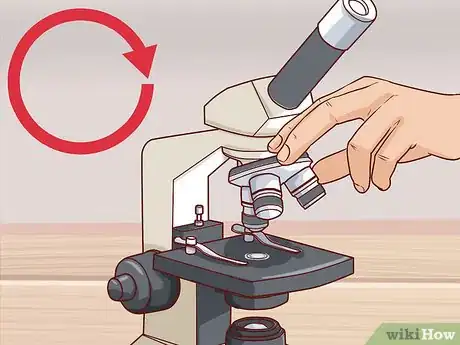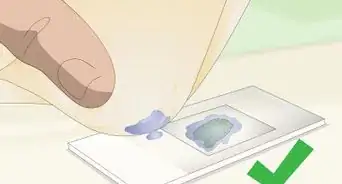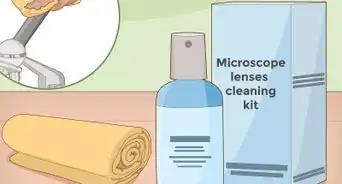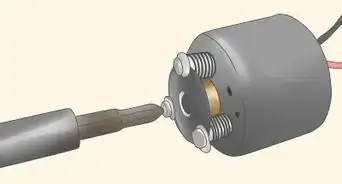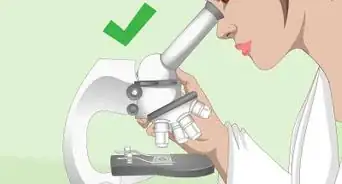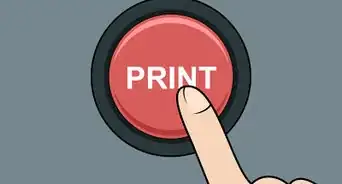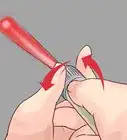This article was co-authored by Bess Ruff, MA. Bess Ruff is a Geography PhD student at Florida State University. She received her MA in Environmental Science and Management from the University of California, Santa Barbara in 2016. She has conducted survey work for marine spatial planning projects in the Caribbean and provided research support as a graduate fellow for the Sustainable Fisheries Group.
This article has been viewed 62,394 times.
A microscope can help you observe things that you can't see with the naked eye, such as bacteria. However, if you do not know how to focus your microscope correctly, you will be unable to view these objects. Getting the best focus on your microscope requires setting it up properly, focusing on your sample, and magnifying the sample so that you can see it.
Steps
Setting Up the Microscope
-
1Find a flat, well-lit area to set up your microscope. To have the best viewing experience with your microscope, it's important that you set it up somewhere flat where there's plenty of light so you can see what you're doing. A sturdy table or desk in a well-lit room will work perfectly.
-
2Turn on the light. The first step in using your microscope is turning on the light. You must be sure that the microscope is plugged in and turned on. A light will appear from below the stage of the microscope.[1]
- The stage is the flat, plate-like surface on the microscope. It holds the slides that you will be observing.
Advertisement -
3Use the lowest magnification. Adjust the nosepiece so that the lowest magnification is in place. This might say 4X or 10X depending on the type of microscope that you are using. It is very important to start with the lowest magnification first in order to achieve the best focus on a microscope.
- The nosepiece is the rotating portion of the microscope above the stage. It will have three or four objective lenses attached to it.
- The objective lenses are the magnifiers that are attached to the nosepiece. They will be labeled with their magnification level, which is typically 4X, 10X, 40X, and 100X. They will also be color coded for your convenience.
-
4Put the slide in place. You will place the slide below the objective on the stage of the microscope. Be sure to center the object you want to magnify directly under the objective. Use the stage clips to hold the slide in place.
- Be sure that the slide is about ¼” away from the objective. To adjust the distance, move the stage up or down.
Focusing the Microscope
-
1Adjust the coarse focus knob. Begin to focus on the object by adjusting the coarse focus knob. This will be the larger of the two knobs on the side of the microscope. Rotate the knob clockwise and counterclockwise until you see the best possible picture through the eyepiece.[2]
- Adjusting the coarse focus knob may not give you optimum clarity. The coarse focus knob is meant to bring the object mostly into focus so that the fine focus knob can be effective.
-
2Adjust the fine focus knob. After you have adjusted the coarse focus knob, you can fine tune your focus by adjusting the fine focus knob. This will be the smaller of the two knobs on the side of the microscope. Just as you did with the coarse focus knob, turn this knob clockwise and counterclockwise until you see the best picture in the eyepiece.[3]
-
3Adjust the stage. You can adjust the stage up and down as well as left and right. Adjusting the stage up and down will bring the object closer or further away. Adjust it left to right if the object that you are viewing is not centered under the objective.[4]
- When adjusting the stage, be sure not to allow the objective lens to touch the slide.
Increasing the Magnification
-
1Move up one magnification. Once you have focused the best picture of the object that you are viewing, you can now increase your magnification. To increase the magnification, turn the nosepiece one click clockwise. The next objective lens will now be pointing towards the slide.[5]
-
2Adjust your focus. Focus the microscope in the same way that you did with the lower magnification. First, use the coarse focus knob. Next, use the fine focus knob. Last, adjust the stage.[6]
- Focus each objective lens before moving to the next magnification. If you skip objective lenses, you will not achieve the best focus possible.
-
3Repeat the magnification process. If you need more magnification, you can repeat the process again with the next one or two magnifications. Remember to focus each objective lens before moving on to the next objective lense.
Community Q&A
-
QuestionHow can I use the coarse focus when the 10x lens is in place?
 Community AnswerWhen the 10x objective lens is in place, the distance between the lens and slide is much smaller than when the lower objective (usually 4x) is in place. This means the coarse focus knob must be used VERY carefully and slowly, not to push it into the slide, break the coverslip or squash your specimen. If you have focused correctly using the lower power lens, when you move the 10x lens into place, the focus will be very close to where you want to be, so only a very small adjustment should be made using the coarse focus knob. Complete the focusing with the fine focus knob. The coarse focus knob should not be used with any higher powered lenses (40x, 100x) - use fine focus only with these.
Community AnswerWhen the 10x objective lens is in place, the distance between the lens and slide is much smaller than when the lower objective (usually 4x) is in place. This means the coarse focus knob must be used VERY carefully and slowly, not to push it into the slide, break the coverslip or squash your specimen. If you have focused correctly using the lower power lens, when you move the 10x lens into place, the focus will be very close to where you want to be, so only a very small adjustment should be made using the coarse focus knob. Complete the focusing with the fine focus knob. The coarse focus knob should not be used with any higher powered lenses (40x, 100x) - use fine focus only with these. -
QuestionHow do I adjust the magnification and resolution?
 Community AnswerThere are generally two focus knobs on a standard microscope. The larger one is known as the "coarse knob", as it zooms in/out by a large degree, while the smaller one is known as the "finer knob", as it zooms in/out in smaller degrees.
Community AnswerThere are generally two focus knobs on a standard microscope. The larger one is known as the "coarse knob", as it zooms in/out by a large degree, while the smaller one is known as the "finer knob", as it zooms in/out in smaller degrees.
Warnings
- Do not touch the lens glass with your finger. You will leave the lens smudged and hard to see through.⧼thumbs_response⧽
- Do not skip objective lenses when increasing your magnification.⧼thumbs_response⧽
References
- ↑ http://www.microscope-microscope.org/basic/microscope-parts.htm
- ↑ http://www.microscope-microscope.org/basic/microscope-parts.htm
- ↑ http://www.microscope-microscope.org/basic/microscope-parts.htm
- ↑ http://www.microscope-microscope.org/basic/microscope-parts.htm
- ↑ http://www.hometrainingtools.com/a/how-to-use-a-microscope-teaching-tip
- ↑ http://www.hometrainingtools.com/a/how-to-use-a-microscope-teaching-tip
